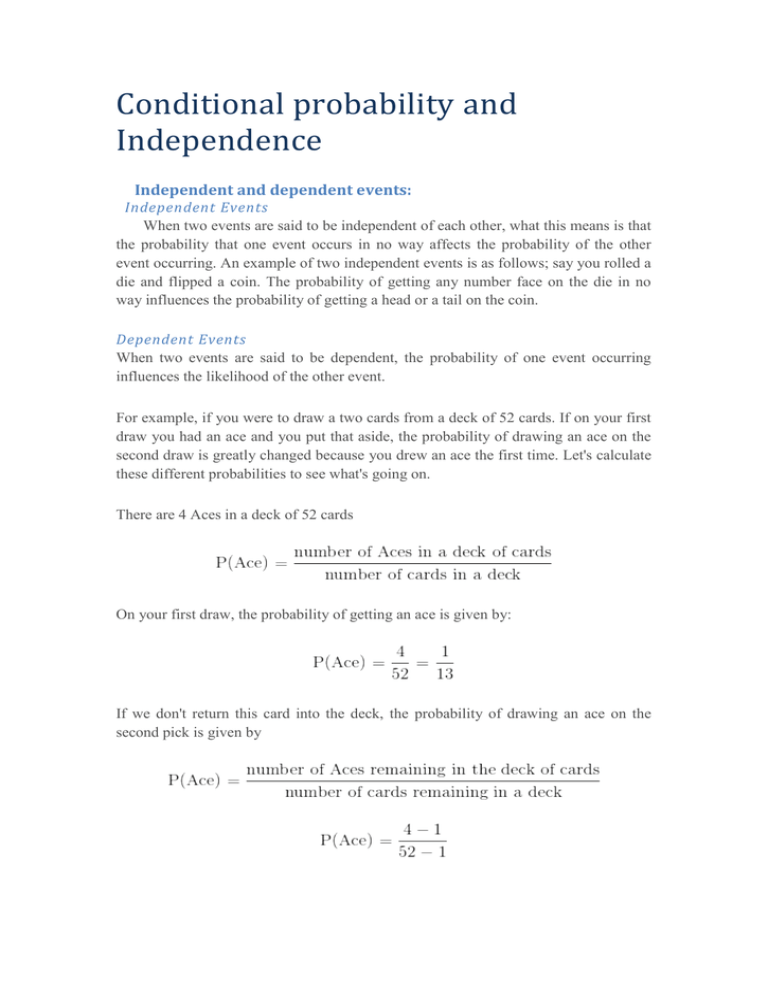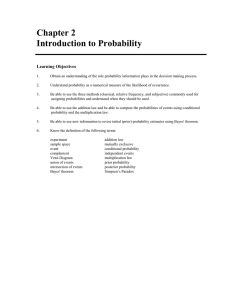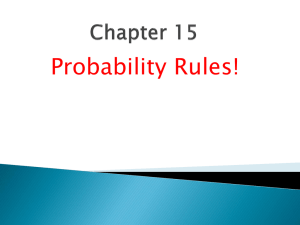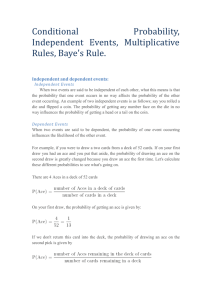lesson3
advertisement

Conditional probability and Independence Independent and dependent events: Independent Events When two events are said to be independent of each other, what this means is that the probability that one event occurs in no way affects the probability of the other event occurring. An example of two independent events is as follows; say you rolled a die and flipped a coin. The probability of getting any number face on the die in no way influences the probability of getting a head or a tail on the coin. Dependent Events When two events are said to be dependent, the probability of one event occurring influences the likelihood of the other event. For example, if you were to draw a two cards from a deck of 52 cards. If on your first draw you had an ace and you put that aside, the probability of drawing an ace on the second draw is greatly changed because you drew an ace the first time. Let's calculate these different probabilities to see what's going on. There are 4 Aces in a deck of 52 cards On your first draw, the probability of getting an ace is given by: If we don't return this card into the deck, the probability of drawing an ace on the second pick is given by As you can clearly see, the above two probabilities are different, so we say that the two events are dependent. The likelihood of the second event depends on what happens in the first event. Conditional Probability: The conditional probability of an event B is the probability that the event will occur given the knowledge that an event A has already occurred. This probability is written P(B|A), notation for the probability of B given A. In the case where events A and B are independent (where event A has no effect on the probability of event B), the conditional probability of event B given event A is simply the probability of event B, that is P(B). If events A and B are not independent, then the probability of the intersection of A and B (the probability that both events occur) is defined by P(A and B) = P(A)P(B|A). From this definition, the conditional probability P(B|A) is easily obtained by dividing by P(A): P( B / A) P( A and B) P( A) or P( B / A) P( A B ) P( A) And also the conditional probability P ( A / B ) is obtained by dividing by P(B ). P( A / B ) P( A and P( B ) B) or P( A / B ) P( A B ) P( B ) Examples: Example1: In a card game, suppose a player needs to draw two cards of the same suit in order to win. Of the 52 cards, there are 13 cards in each suit. Suppose first the player draws a heart. Now the player wishes to draw a second heart. Since one heart has already been chosen, there are now 12 hearts remaining in a deck of 51 cards. So the conditional probability P(Draw second heart|First card a heart) = 12/51. Example2: Suppose an individual applying to a college determines that he has an 80% chance of being accepted, and he knows that dormitory housing will only be provided for 60% of all of the accepted students. The chance of the student being accepted and receiving dormitory housing is defined by P(Accepted and Dormitory Housing) = P(Dormitory Housing|Accepted)P(Accepted) = (0.60)*(0.80) = 0.48. Example3: Suppose that somebody secretly rolls two fair six-sided dice, and we must predict the outcome. Let A be the value rolled on die 1 Let B be the value rolled on die 2 What is the probability that A = 2? Table 1 shows the sample space of 36 outcomes Clearly, A = 2 in exactly 6 of the 36 outcomes, thus P ( A 2) + Table 1 B=1 2 3 4 5 6 A=1 2 3 4 5 6 7 2 3 4 5 6 7 8 3 4 5 6 7 8 9 4 5 6 7 8 9 10 5 6 7 8 9 10 11 6 7 8 9 10 11 12 6 1 36 6 Suppose it is revealed that A+B ≤ 5 What is the probability A+B ≤ 5 ? Table 2 shows that A+B ≤ 5 for exactly 10 of the same 36 outcomes, thus 10 5 P( A B 5) 36 18 + Table 2 B=1 2 3 4 5 6 A=1 2 3 4 5 6 7 2 3 4 5 6 7 8 3 4 5 6 7 8 9 4 5 6 7 8 9 10 5 6 7 8 9 10 11 6 7 8 9 10 11 12 What is the probability that A = 2 given that A+B ≤ 5 ? Table 3 shows that for 3 of these 10 outcomes, A = 2 Thus, the conditional probability P( A 2 / A B 5) + Table 3 B=1 2 3 4 5 6 A=1 2 3 4 5 6 7 2 3 4 5 6 7 8 3 4 5 6 7 8 9 4 5 6 7 8 9 10 5 6 7 8 9 10 11 6 7 8 9 10 11 12 3 10 Bayes's formula: Another important method for calculating conditional probabilities is given by Bayes's formula. The formula is based on the expression P(B) = P(B|A)P(A) + P(B|Ac)P(Ac), which simply states that the probability of event B is the sum of the conditional probabilities of event B given that event A has or has not occurred. For independent events A and B, this is equal to P(B)P(A) + P(B)P(Ac) = P(B)(P(A) + P(Ac)) = P(B)(1) = P(B), since the probability of an event and its complement must always sum to 1. Bayes's formula is defined as follows: P( B / A) P( A) P( A / B ) P( B / A) P( A) P( B / Ac ) P( Ac )







